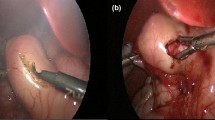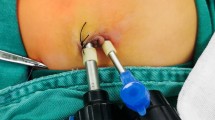Abstract
Introduction
Pyloromyotomy is the standard care for hypertrophic pyloric stenosis. The traditional approach for this procedure is a right upper quadrant transverse incision, although other “open” approaches, such as circumumbilical or periumbilical incision have been described. The more recent approach used is laparoscopic pyloromyotomy (LP), but experience feedback is still debated and its benefits remain unproven. The aim of this study was to make a review of all our LP procedures with an objective evaluation according to the literature.
Methods
A retrospective analysis of all the LPs performed in one University Children’s Hospital between 1 January 1996, and 30 December 2015 was realized. Information regarding the patient’s status, intraoperative and postoperative data was analyzed.
Results
407 patients were included in this study. The mean operative time of the overall procedure was 24 ± 13 min, which significantly increased with the length of the pyloric muscle (p = 0.004) and significantly impacted the full feeding time (p = 0.006). 3.4% required conversion to an open procedure during the LP. We observed a significant correlation between conversion for mucosal perforation and weight loss (p = 0.04) and between conversion for mucosal perforation and preoperative weight (p = 0.002). A redo procedure was indicated in 3.7%, for incomplete pyloromyotomy each time. The mean postoperative hospital length of stay for all procedures was 1.6 ± 0.8 days. There were no inflammatory scars. None had incisional hernias or wound dehiscence.
Discussion
LP procedure appeared to be as quick as the open procedure. Our results were similar to others series for intraoperative complications. According to operative time, this technique does not have an impact on operative room utilization. Vomiting duration at presentation in HPS does not seem to have a significant impact on postoperative outcomes. LP procedure causes little pain during the postoperative period. No wound complications were registered.
Similar content being viewed by others
References
Cascio S et al (2013) Hypertrophic pyloric stenosis in premature infants: evaluation of sonographic criteria and short-term outcomes. Pediatr Surg Int 29(7):697–702
Stark CM et al (2015) Association of prematurity with the development of infantile hypertrophic pyloric stenosis. Pediatr Res 78(2):218–222
Tan KC, Bianchi A (1986) Circumumbilical incision for pyloromyotomy. Br J Surg 73(5):399
Lazar D et al (2008) Transumbilical pyloromyotomy with umbilicoplasty provides ease of access and excellent cosmetic results. J Pediatr Surg 43(7):1408–1410
Siddiqui S et al (2012) Pyloromyotomy: randomized control trial of laparoscopic vs open technique. J Pediatr Surg 47(1):93–98
Alain JL, Grousseau D, Terrier G (1991) Extramucosal pyloromyotomy by laparoscopy. Surg Endosc 5(4):174–175
Binet A, Bastard F, Meignan P, Braïk K, Touze AL, Villemagne T, Morel B, Robert M, Klipfel C, Lardy H (2017) Laparoscopic pyloromyotomy: a study of the learning curve. Eur J Pediatr Surg. https://doi.org/10.1055/s-0037-1603090
Carrington EV et al (2012) Cost-effectiveness of laparoscopic versus open pyloromyotomy. J Surg Res 178(1):315–320
Hall NJ et al (2004) Meta-analysis of laparoscopic versus open pyloromyotomy. Ann Surg 240(5):774–778
Oomen MW et al (2010) Learning curves for pediatric laparoscopy: how many operations are enough? The Amsterdam experience with laparoscopic pyloromyotomy. Surg Endosc 24(8):1829–1833
Sola JE, Neville HL (2009) Laparoscopic vs open pyloromyotomy: a systematic review and meta-analysis. J Pediatr Surg 44(8):1631–1637
St Peter SD et al (2006) Open versus laparoscopic pyloromyotomy for pyloric stenosis: a prospective, randomized trial. Ann Surg 244(3):363–370
Jia WQ et al (2011) Open versus laparoscopic pyloromyotomy for pyloric stenosis: a meta-analysis of randomized controlled trials. Eur J Pediatr Surg 21(2):77–81
Leclair MD et al (2007) Laparoscopic pyloromyotomy for hypertrophic pyloric stenosis: a prospective, randomized controlled trial. J Pediatr Surg 42(4):692–698
Hall NJ et al (2009) Recovery after open versus laparoscopic pyloromyotomy for pyloric stenosis: a double-blind multicentre randomised controlled trial. Lancet 373(9661):390–398
Zani-Ruttenstock E et al (2015) Are paediatric operations evidence based? A prospective analysis of general surgery practice in a teaching paediatric hospital. Pediatr Surg Int 31(1):53–59
Ballouhey Q et al (2016) Differential learning processes for laparoscopic and open supraumbilical pyloromyotomy. Pediatr Surg Int 32(11):1047–1052
Dindo D, Demartines N, Clavien P-A (2004) Classification of surgical complications: a new proposal with evaluation in a cohort of 6336 patients and results of a survey. Ann Surg 240(2):205
Debillon T et al (2001) Development and initial validation of the EDIN scale, a new tool for assessing prolonged pain in preterm infants. Arch Dis Child Fetal Neonatal Edn 85(1):F36–F41
van der Bilt JD et al (2004) Laparoscopic pyloromyotomy for hypertrophic pyloric stenosis: impact of experience on the results in 182 cases. Surg Endosc 18(6):907–909
Hall NJ et al (2014) Risk of incomplete pyloromyotomy and mucosal perforation in open and laparoscopic pyloromyotomy. J Pediatr Surg 49(7):1083–1086
Sathya C et al (2017) Laparoscopic versus open pyloromyotomy in infants: a systematic review and meta-analysis. Pediatr Surg Int 33(3):325–333
Ostlie DJ et al (2004) An effective pyloromyotomy length in infants undergoing laparoscopic pyloromyotomy. Surgery 136(4):827–832
St Peter SD, Ostlie DJ (2008) Pyloric stenosis: from a retrospective analysis to a prospective clinical trial—the impact on surgical outcomes. Curr Opin Pediatr 20(3):311–314
Adibe OO et al (2006) Comparison of outcomes after laparoscopic and open pyloromyotomy at a high-volume pediatric teaching hospital. J Pediatr Surg 41(10):1676–1678
Campbell BT et al (2002) A comparison of laparoscopic and open pyloromyotomy at a teaching hospital. J Pediatr Surg 37(7):1068–1071 (discussion 1068–1071)
Hall NJ et al (2004) Retrospective comparison of open versus laparoscopic pyloromyotomy. Br J Surg 91(10):1325–1329
Sitsen E, Bax NM, van der Zee DC (1998) Is laparoscopic pyloromyotomy superior to open surgery? Surg Endosc 12(6):813–815
Yagmurlu A et al (2004) Comparison of the incidence of complications in open and laparoscopic pyloromyotomy: a concurrent single institution series. J Pediatr Surg 39(3):292–296 (discussion 292–296)
Ford WD, Crameri JA, Holland AJ (1997) The learning curve for laparoscopic pyloromyotomy. J Pediatr Surg 32(4):552–554
Kim SS et al (2005) Pyloromyotomy: a comparison of laparoscopic, circumumbilical, and right upper quadrant operative techniques. J Am Coll Surg 201(1):66–70
Al-Jazaeri A et al (2011) Can the duration of vomiting predict postoperative outcomes in hypertrophic pyloric stenosis? Ann Saudi Med 31(6):609
Lee SL, Stark R (2011) Can patient factors predict early discharge after pyloromyotomy? Perm J 15(2):44
Cohen MM et al (1994) The postoperative interview: assessing risk factors for nausea and vomiting. Anesth Analg 78(1):7–16
GREASON KL et al (1997) A prospective, randomized evaluation of laparoscopic versus open pyloromyotomy in the treatment of infantile hypertrophic pyloric stenosis. Pediatr Endosurg Innov Tech 1(3):175–179
Fujimoto T et al (1999) Laparoscopic extramucosal pyloromyotomy versus open pyloromyotomy for infantile hypertrophic pyloric stenosis: which is better? J Pediatr Surg 34(2):370–372
Adibe OO et al (2007) Ad libitum feeds after laparoscopic pyloromyotomy: a retrospective comparison with a standardized feeding regimen in 227 infants. J Laparoendosc Adv Surg Tech A 17(2):235–237
van der Bilt JD et al (2004) Early feeding after laparoscopic pyloromyotomy: the pros and cons. Surg Endosc 18(5):746–748
Luciani JL et al (1997) Prognostic factors of the postoperative vomiting in case of hypertrophic pyloric stenosis. Eur J Pediatr Surg 7(2):93–96
Attwood SE et al (1992) A prospective randomized trial of laparoscopic versus open appendectomy. Surgery 112(3):497–501
Rumsey N, Harcourt D (2004) Body image and disfigurement: issues and interventions. Body Image 1(1):83–97
Martigne L et al (2009) P. 43 Prévalence du reflux gastro-œsophagien (RGO) chez l’enfant et l’adolescent en France: résultats d’une étude observationnelle transversale. Gastroentérol Clin Biol 33(3):A40
MacMahon B (2006) The continuing enigma of pyloric stenosis of infancy: a review. Epidemiology 17(2):195–201
Mc KT, Mac MB, Record RG (1951) The familial incidence of congenital pyloric stenosis. Ann Eugen 16(3):260–281
Author information
Authors and Affiliations
Corresponding author
Ethics declarations
Conflict of interest
All authors declare no conflicts of interest or financial ties to disclose.
Rights and permissions
About this article
Cite this article
Binet, A., Klipfel, C., Meignan, P. et al. Laparoscopic pyloromyotomy for hypertrophic pyloric stenosis: a survey of 407 children. Pediatr Surg Int 34, 421–426 (2018). https://doi.org/10.1007/s00383-018-4235-3
Accepted:
Published:
Issue Date:
DOI: https://doi.org/10.1007/s00383-018-4235-3




